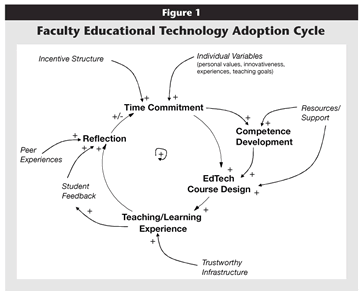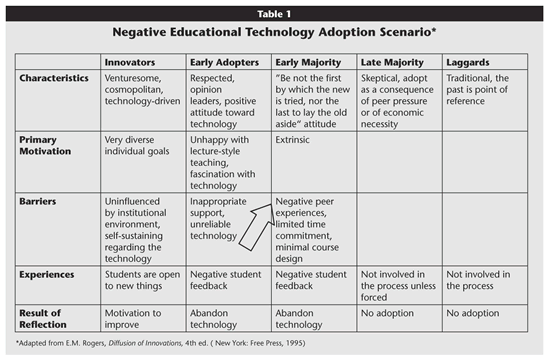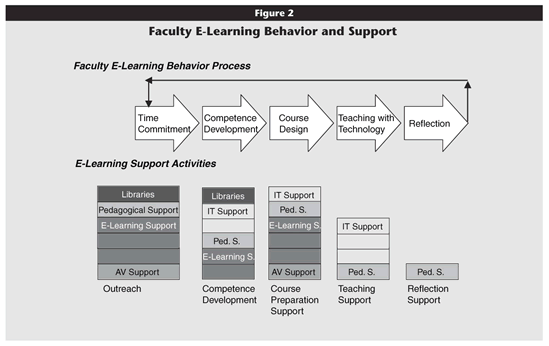Roughly 10 years into the e-learning age, educational technology has made only modest inroads into changing teaching in universities.1 In Europe, and in Switzerland in particular, governmental programs implemented in the late 1990s aimed to exploit the potential of educational technology and keep pace with developments in Anglo-Saxon countries. An early lesson from these programs was the lack of sustainability of a pure project-funding approach and the need for institutional strategies regarding educational technology.2 The search for such strategies at U.S. research universities was the starting point for my doctoral dissertation.
An initial survey of nine higher education institutions leading educational technology development in the Boston metropolitan area clearly showed that U.S. institutions wrestle with issues similar to those at their European counterparts. Most striking was the issue of faculty resistance across the institutions, whether top-ranked research universities or large public institutions heavily engaged in continuing education.3 I narrowed the focus of my research to educational technology support strategies and tried to understand the mechanisms guiding faculty behavior regarding educational technology.
Thus, I selected three highly interesting but very different universities—MIT, Tufts, and Northeastern—for in-depth case studies into this issue. My research consisted of more than 50 interviews at these institutions, as well as document analysis, participant observation, and focus groups. The thorough data-analysis process followed grounded theory procedures.4
Faculty Educational Technology Adoption Cycle
Although faculty support has been identified as a critical factor in the success of educational-technology programs, many people involved in such efforts underestimate the complexities of integrating technology into teaching.6 Based on the research for my dissertation, I propose an adoption cycle (see Figure 1) to help tackle this complex issue of technology adoption for teaching. The center depicts a circuit of faculty behavior activities (bold), which are influenced by several outside factors and conditions (italic).

Click image for larger view.
The time faculty spend integrating educational technology into their teaching lies at the core of this model. Because time is a scarce resource and many other activities compete for faculty attention, time commitment illustrates the value and importance assigned to an activity, as emphasized by a Tufts faculty member: "At the end of the day, since in my mind the most important factor is time, investment has to reflect the fact that we recognize people's time."
Time commitment depends both on organizational incentive structures (extrinsic motivation) and on individual variables (intrinsic motivation). The heuristic model proposes a positive causal relationship between time commitment and competence development. Time commitment is the prerequisite for an involvement in competence development and an engagement in course (re-)design activities. Competence development, in turn, has a positive impact on the quality of course design. The availability of support services and other resources (such as course release time) are important to competence development and the quality of course design.
Following the model through its progression, the quality of the course design is a major determinant of the teaching and learning experience. The reliability of technology can affect the teaching and learning progress considerably. As noted by a faculty member at Northeastern University, "There was some issue with the network .... So we had some growing pains. I actually stopped using Blackboard for a while because ... my teaching evaluations went down, and I needed to get tenure before I started doing more off-the-beaten-track stuff."
A number of factors inform the reflection process, including an institutionalized student-feedback mechanism, individual experiences of the teacher, and input from peers. A faculty member at MIT reported that team teaching had positive implications by way of peer pressure and competitiveness. The opposite effect is widespread as well. Reports of negative faculty experiences travel fast and influence the opinions of the larger community. This assessment part of the adoption cycle will result either in increased or diminished time commitment, which leads to another cycle of design activity and experience.
The faculty educational technology adoption cycle can take form of a self-reinforcing mechanism. An example of a positive cycle was observed at Northeastern University. Several winners of the university's "Effective or Innovative Use of Technology in Teaching Awards" were first-time users of the institution's learning management system. In some cases, however, the connection between reflection on experiences and time commitment is not clear. In my work with faculty at a Swiss institution, I observed some faculty who were eager to invest time to correct an unsatisfactory course design—a clearly negative relationship between experiences and time commitment. If technology was involved, however, faculty were quick to blame the failure on the technology and abandon newly acquired teaching practice and technology use (a clearly positive relationship).
Implications
Although important variables influencing faculty adoption behavior need to be reflected at a strategic level, such as the shape of an adequate incentive structure, the proposed model of faculty technology adoption reveals support needs. Furthermore, an empirical validation of the proposed relations is necessary. Nevertheless, the following scenarios illustrate important implications of the proposed cycle and the need for faculty support.
What If Professional Support Is Established Too Late?
At all of the investigated institutions, innovative faculty have for many years been motivated by an intrinsic desire to develop interesting projects that illustrate the potential of educational technology in higher education. Imitators have then generated additional interest, and a case can be made for institutional support. If appropriate and sufficient support is not provided, particularly in competence development and educational technology course design, these early adopters' efforts may attain only mediocre quality. If early adopters experience too many setbacks, their negative reporting may lead to skepticism among the early majority, who will be tentative in their adoption of technology. These conditions discourage quality course design, and negative experiences are likely (see Table 1). As a result of this process, early adopters and the early majority will abandon use of technology, and the late majority and laggards will not even start adopting it. Only the innovators will continue to experiment with technology, based on their intrinsic motivation.

Click image for larger view.
A more strategic approach might prevent this negative dynamic. One important dimension is the development of adequate expectations about faculty requirements and how much effort and competence are necessary to successfully incorporate educational technology. If an institution's stated strategy is to promote the use of educational technology, that institution must establish an adequate framework for faculty to use technology successfully.5 This includes not only formal incentive structures but also the development of a sufficient educational technology infrastructure and a satisfactory framework for educational technology support.
What If Support Is Absent in Critical Phases?
On most campuses, faculty rely not only on dedicated units for educational technology support but also on the work of IT units, audio/video support, teaching and learning centers, and the libraries. My analysis of support activities suggests there are corresponding support activities in each phase of the adoption cycle. However, faculty do not receive adequate attention from support units in all phases. Subsequently, critical aspects are discussed for all phases. Figure 2 shows the faculty e-learning behavior process (top) and e-learning support activities (bottom). In each phase, different support groups provide services, but the overall level of support for faculty varies considerably from phase to phase.

Click image for larger view.
To understand the different approaches tooutreach, it is important to focus on the difference in nature of educational technology support from regular IT services. IT is central to faculty work, and support requirements arise when daily work is hindered. By contrast, marketing educational technology is more challenging because faculty in most cases do not depend on it. First they must be convinced of the need for a different mode of teaching to understand the full potential of educational technology. For this reason, educational technology groups invest substantial energy into communication and outreach activities and often cooperate with pedagogical support groups or libraries to reach faculty. They also work to build strategic alliances with department heads, establish advisory boards, and maintain well-structured Web sites.
Many faculty lack the necessary technical and pedagogical competencies to successfully integrate educational technology into their teaching. Institutions offer formal and informal modes ofcompetence development, but the kinds of offerings vary substantially at the institutions I studied.
Moreover, institutions take different approaches to supportcourse design, with the particular approach often determined by the project's size. Larger projects that rely on third-party funding offer interesting opportunities for collaborations across various support groups.
In the teaching phase, systematic support that goes beyond troubleshooting of IT issues is rarely offered. Support forreflection and evaluation for a course that has been taught are even scarcer.
Educational technology support requires more than simply stringing together standard services, however. A pedagogical consultant at Northeastern University said, "You have to be seen as part of a larger group to have an impact.... We do it by offering a wide variety of programs so that I get a little of everything for everybody." A successful program to support educational technology encompasses a well-rehearsed set of scaleable support offerings, customized consulting, and fostering a community involving various faculty and various support groups. These activities must be communicated to establish an intelligible identity.
Fostering Educational Technology Support
The following recommendations were derived from the faculty educational technology adoption cycle:
In all phases of the technology adoption cycle, faculty require adequate support. In particular, the phases of teaching and reflection require more attention from support units to avoid the negative dynamic described above. Assisting faculty in the reflection phase with competent advice and convincing perspectives is crucial in keeping the adoption process going. To establish a support network, an institution must also initiate a strategic process to establish favorable support conditions and a support culture. This is the main focus of my dissertation, The Strategic Management of Faculty Support at American Research Universities, available from .
